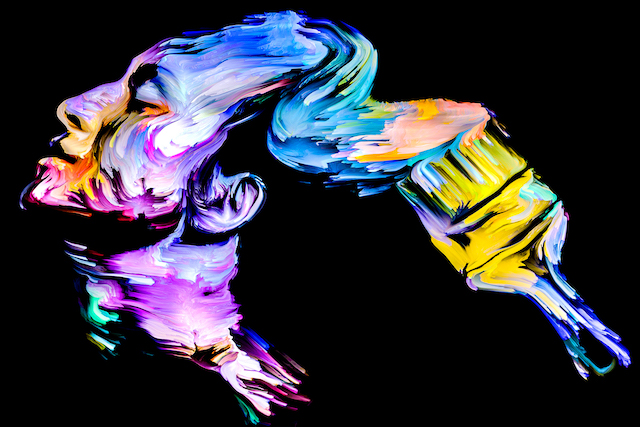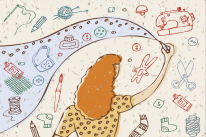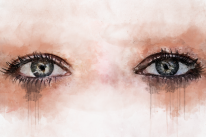
“The discipline of creation, be it to paint, compose, write, is an effort toward wholeness.” ~Madeleine L’engle.
Heartbreak, sadness, and loss are uniting experiences across humanity—all of us are likely to experience grief in some form.
In grief, it can be common to feel lost, demotivated, depressed, and also, to experience a loss of self-esteem; it’s difficult to feel good about yourself when you’re processing all of the emotions that go along with grieving.
Developing a regular creative practice can be a helpful, healing way through loss. I used a creative practice to help find my way through a time of immense sadness and change—a divorce.
When my relationship ended after sixteen years, there wasn’t a single aspect of my life that remained the same: my family, friendships, the way I parented, where I lived, my work and financial situation—every aspect of my life changed dramatically.
It was a huge time of change that I termed “reinvention,” and I rebuilt my life from the ground up.
I grieved the loss of a family, of the amount of time I had with my son, and the fact he was now a child of a split family. I grieved the possibility I would never have more children, and the picture I had for my future life.
In my experience, grief is something you work through over a period of years. As the old adage says, it takes time. As humans, we experience grief in many forms, so while causes of grief and individual experiences differ between people, I think there are lessons and experiences that we can share.
I have completed several Photography 365 projects over the last six years since my divorce. These have been the foundation for creativity and gratitude practices that are now the cornerstones of my life.
Whether you are a creative person trying to maintain your creativity or someone who is looking for a tool to help you through grief, developing a regular creative practice will be helpful.
When you’re grieving, it can feel as if everything in your life has changed, and often it has. Creativity can be a solid, comforting, and familiar friend—a pillar of self-support.
A creative practice is any creative activity you undertake on a regular (preferably daily) basis. Ways of utilizing and growing your creativity are virtually limitless—from cooking, to coloring, car-restoration, and on to calligraphy.
The key is to find an accessible, achievable activity that works for you, that you can commit to adding into your life. (If you’re grieving, consider leaving that larger-than-life art installation for now, and focus on something you can work on in your pajamas if need be!)
Make no mistake, establishing a creative practice takes effort, commitment, and discipline, just like many of the most worthwhile things in life. But it will reward you, again and again.
Creativity has the ability to become a cornerstone of your life, as well as a pathway through grief, and a stimulant of huge growth.
Creativity shares a trait with grief that is not commonly acknowledged: They can both be tools for growth. Typically, grief throws down challenges you wonder whether you have the strength to bear, but which, over time, you can learn to live with, heal from, and even thrive because of.
Creativity, in a gentler fashion, can do the same. It will undoubtedly stretch and challenge you, but can be gentler than grief, because you can actually enjoy it! Choose an activity you love, are curious about, or have always wanted to try, and surrender to the healing power of creativity.
Here are some key ways that creativity and a daily creative practice helped me, and can help you.
Creativity challenges us to look for (and find) the beauty in every day.
The world can look grey through grief. The shine disappears from everything and you feel as though you’re looking at the world through an ever-present veil.
My creative practice—a Photography 365 Project where I took a photograph of my life every day for a year—helped (and forced!) me to look for something beautiful in life, every single day.
Some days this was a struggle, but if I took a poor-quality, boring picture, it made me feel worse to look at it, and I realized I felt much better when I took a great picture. So I kept looking for beautiful pictures to take, one day at a time.
Creativity provides a focus and something to look forward to.
I completed my photography 365 projects with a group of like-minded women from all over the world. We shared our pictures online, became a part of each other’s daily lives, and helped motivate and support each other. We brainstormed, counseled, shared ideas, and held space.
I cannot emphasize how critical a group of like-minded souls will be to helping you complete a sustained creative project. I not only looked forward to discovering what my photo of the day would be, but I looked forward to seeing what everyone else found as well.
A cheerleading squad in the form of an online community, a virtual or real class, or a group to join can be enormously helpful as you develop your creative habit.
Seeing something beautiful in every day makes us grateful for the good in our lives.
Looking for the photo of the day became a daily, all-day search. I became far more aware of all that was around me: I chased the light, examined people’s faces, noticed nature, and raised my eyes to the horizon. I became an observer of the beauty of life, which helped me on the days I felt too sad, overwhelmed, or exhausted to be my beautiful self.
The irony was, that by capturing the beauty in photographs, I became part of it, and as I recorded it I had it to look back on as proof. Proof that life was still good—that there were good moments in every day.
As I worked through my 365 Project, it inspired me to begin another 365 Project, where the subject was consciousness.
As I found my feet through grief, I bought a tiny red diary where I recorded one forward step toward my dreams (no matter how small) every day. I also wrote down what I was grateful for in each day, and the good things that had happened.
(Note: the size of the diary was important in this project for me. I didn’t want to feel overwhelmed by 365 large blank pages, so I deliberately bought the tiniest diary I could find. Just a small space to fill each day, with one forward step. It helped).
Creativity provides a daily outlet for feelings and emotions.
It’s important to be honest with yourself and others about how you’re feeling, particularly in grief. A creative practice provides you with a forum in which you can check in with your feelings.
You turn up to the page, the canvas, or the camera. You breathe, and then you feel. Your inner dialogue becomes the window through which you make or create. You can feel, process, and then let your emotions go when you express them creatively.
The beauty of this is that the process is two-way. I made art to express my feelings, and I took photographs that depicted sadness, vulnerability, love, emptiness, loneliness, hope, and many other feelings. But in the main, I wanted to make beautiful art—art that lifted me up. So I made art to express my feelings, but I also felt better because I made beautiful art.
Creativity is a portal into joy. No matter your age, stage, ability, or creative outlet, creativity gives you a place to simply be, to turn up, and either feel all there is to feel, or lose yourself entirely in the creative process.
Chances are, you’ll do both. And while you do, creativity will be working its magic in your life—slowly but surely stepping you toward greater joy. When you’re grieving, these can feel like small steps, and it does take time. But if you persist, if you can open your heart to allow creativity in, you will succeed.
Creativity can improve your self-esteem.
Creating through grief can be difficult, because creativity is linked to self-esteem (creativity and self-esteem both sit in the sacral chakra). When we’re heartbroken, self-esteem can suffer.
As a highly creative person, I was often frustrated by my grief, because it made creating so difficult. The effort required to push through the sadness, exhaustion, overwhelm, and all that was going on as I rebuilt my life made completing the big projects in my head seem almost impossible.
And yet, by breaking my creativity down into tiny daily tasks, creativity became manageable, and I accomplished a long-held goal: I documented my daily life in photographs for an extended period of time, creating a body of work for a solo exhibition.
Ultimately, how I chose to respond to my divorce led to me stepping fully into my creative purpose and life as an artist. Creativity helped me heal, and what I clung to in a difficult time has been reinforced as my greatest strength.
—
We do not always choose what happens to us in life, but we do choose how we respond. Creativity is an invaluable component of our lives, whether we’re in grief or not; and its powerful healing properties are transformational.
About Katherine Parrott
Katherine Parrott is a creativity coach, writer, artist, and photographer who helps soulful women unlock their creative genius so they can live full, free, rich lives. By taking small, significant steps her clients are able to transform their lives. Katherine offers long-term and short-term coaching, including the VIP One Day Virtual Creative Retreat. She can be found at katherineparrott.com and on Facebook.













 Though I run this site, it is not mine. It's ours. It's not about me. It's about us. Your stories and your wisdom are just as meaningful as mine.
Though I run this site, it is not mine. It's ours. It's not about me. It's about us. Your stories and your wisdom are just as meaningful as mine. 